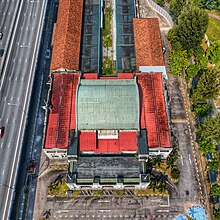Tanjong Pagar railway station
[2][3] The main building of the railway station was gazetted as a national monument on 9 April 2011,[4] completing one of the objectives of the new Points of Agreement between Malaysia and Singapore.Previously, passengers and goods, particularly to service the transportation of tin and rubber industry in Malaya were transferred at Woodlands to a ferry to Johor Bahru and the connecting train on the peninsula.With the emergence of steamships and growth of shipping industry, Tanjong Pagar Dock Company was formed in 1864, building wharves in the area.Upon arriving in TPRS's main hall, the first thing that many encountered was Habib Railway Book Store and Money Changer.Having lived and worked there most of his life, Lim also mentioned that the hotel exuded a strong colonial ambience, with massive rooms having high ceilings and restaurant's waiters dressed in white with silver buttons.The popularity of the hotel began declining in the 1970s due to physical deterioration of the station building and the negligence of maintenance by the Malayan Railway authorities.Though supported by some, the closure was opposed and lamented by others as representing a great loss of Singapore's heritage and of a key public transportation facility.In 2015, the Urban Redevelopment Authority (URA) proposed that the station be converted into multi-functional community space as part of the revamp of the Rail Corridor stretching from Kranji to Tanjong Pagar.[6] Facilities such as an auditorium and art gallery would be added, and the Railway Corridor would become a linear park that would be nearly ten times longer than New York's High Line.[12] When the two countries established border controls, both the Malaysian and Singaporean Customs, Immigration and Quarantine (CIQ) officers were stationed at Tanjong Pagar for clearance of railway passengers.[13] However, in June 1997 Malaysia stated that the Malaysia-Singapore Points of Agreement of 1990 would come into effect only after it decided to relocate Tanjong Pagar station.Under Malaysian law, it is Johor Bahru railway station, not Tanjong Pagar, that is gazetted as an Immigration Control Post for persons travelling by train from Singapore to Malaysia.[18][19] On 24 May 2010, a meeting between Malaysian Prime Minister Najib Razak and his Singaporean counterpart Lee Hsien Loong in Singapore resolved the relocation issue.Both sides agreed to create a consortium called M-S Pte Ltd, of which 60% equity is owned by Malaysia's Khazanah Nasional Berhad and 40% by Singapore's Temasek Holdings Ltd.


Tanjong Pagar MRT stationKTM IntercitySingapore Land AuthorityWest Coast LineArt DecoNational Heritage BoardKeretapi Tanah MelayuBukit TimahPadang BesarNorth–South LineNational monument of SingaporeSingaporeterminusMalaysiaWoodlands Train CheckpointCantonment MRT stationCircle MRT lineJohor-Singapore CausewayStraits of JohorWoodlandsJohor BahrupeninsulaCecil ClementiKuala LumpurPeninsular MalaysiaTanjong PagarOutram Park MRT stationsMalaysia–Singapore Points of Agreement of 1990Urban Redevelopment AuthorityKranjian underground MRT stationlinear parkHigh Linereliefsmarbleallegoriesbarrel vaultbullock cartborder controlcausewayWoodlands, SingaporeMalaysia-Singapore Points of Agreement of 1990Johor Bahru railway stationpassportsMinistry of Foreign AffairsNajib RazakLee Hsien LoongBukit Timah railway stationMarina OneMarina Bayrapid transit link between Johor Bahru and SingaporeIbrahim Ismail of JohorIsmail of JohorRail transport in SingaporeEastern and Oriental ExpressMalaysia–Singapore borderChineseThe SunThe StarThe Straits TimesChannel NewsAsiaBernamaWest CoastLineKTM ETSSegamatKluangRengamLayang-LayangKempas BaruJohor Bahru SentralEast CoastLineTumpatWakaf BharuPasir MasBukit PanauTanah MerahKuala KraiDabongSri JayaGua MusangMerapohChegar PerahPadang TengkuKuala LipisKerambitJerantutMentakabMengkarakTriangKemayanNational monuments of SingaporeOld Thong Chai Medical InstitutionArmenian ChurchSt Andrew's CathedralFormer Telok Ayer MarketThian Hock KengSri Mariamman TempleMasjid Hajjah FatimahCathedral of the Good ShepherdNagore DurghaMasjid Al-AbrarHouse of Tan Yeok NeeTan Si Chong SuMasjid JamaeSultan MosqueSaint George's ChurchHong San SeeSri Srinivasa Perumal TempleMasjid Abdul GaffoorSiong Lim TempleRaffles HotelTelok Ayer Chinese Methodist ChurchGoodwood Park Hotel (Tower Block)Caldwell HouseConvent of the Holy Infant Jesus ChapelThe IstanaSri TemasekCity HallVictoria Theatre and Concert HallOld Parliament House and Annex BuildingOld Supreme Court BuildingEmpress Place BuildingNational Museum of SingaporeFormer Saint Joseph's InstitutionFormer Attorney-General's ChambersSun Yat Sen Nanyang Memorial Hall